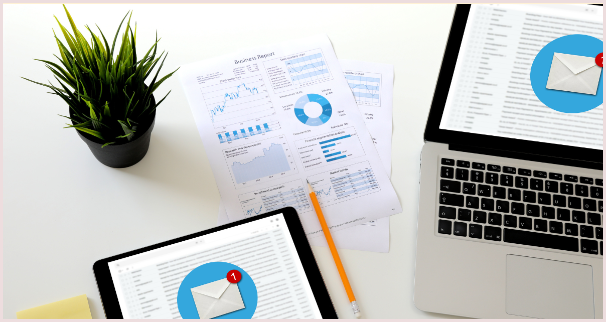Critical eCommerce Email Marketing Mistakes to Avoid

You’ve meticulously categorized the products on your eCommerce site, streamlined the payments, polished your social media presence, and now you want to go into email marketing.
Well, the quest to set up email marketing can get a bit tricky because it’s not easy to keep the recipients engaged with every single email you send.
We’d like to see your business succeed, so we’ve identified six of the biggest mistakes that email marketers make. We’ll see what makes each of these mistakes harmful and how you can overcome them.
By the end of this article, you’ll know how to spot a bad email a mile off and turn others’ mistakes to your advantage, and use emails as effective marketing tools.
So let’s get started.
Sending Too Many Marketing Emails
We’ll start with the most blatant email marketing mistake—one that’s, luckily, among the easiest ones to avoid.
If you want to keep your customers, don’t email them too often.
While it can be tempting to notify the customers every time you add a new item to your online store, think of the last time you clicked the unsubscribe button (which probably wasn’t that long ago).
The email that triggered you to do so could have been well-designed and embellished with custom content, but wasn’t important enough to justify being subscribed to. It was simply one email too many in your already crowded inbox.
In fact, too frequent marketing emails are the leading cause of why recipients unsubscribe from the messages they used to receive, according to a 2021 survey.
If you need some context for understanding the severity of this marketing mistake, here’s a screenshot of an inbox whose owner stopped opening emails from a certain eCommerce company before eventually unsubscribing.
As you can see, not even huge discounts and promotions were enough to keep the customer.
Your brand doesn't have to suffer the same fate, though. You can avoid making such a mistake by making sure your emails are sent less frequently and are 100% relevant for the customers.
Doing that manually would be laborious, so it’s easier to use a marketing tool that lets you send relevant automatic emails based on your customers’ actions.
Flashy, our marketing automation platform, lets you set automatic triggers and then sends appropriate emails after the customers take particular steps.
For instance, when the algorithm registers a customer’s activity around a certain product, it could later email that customer about products that are frequently used together with it.
That way, you could nudge just that interested customer toward another purchase without spamming others. Highly specific customer segmentation is key for keeping your emails opened, read, and acted upon.
Remember, when a customer gives you their email address, you don’t want to break their trust by crowding their inbox. Instead, you’ll be able to maintain good customer relationships by only emailing them when you have something important and highly relevant to say.
Not Optimizing Emails for Mobile Devices
When customers open your emails, you want them to have a beautiful user experience every time, which is why you should watch out for a common email marketing mistake of not optimizing content for mobile devices.
And that matters because less than half of people use their desktop computers to open emails. According to a 2022 report by HubSpot, as many as 60% of people read emails on smartphones and tablets.
Knowing that, you wouldn’t want to risk your email looking like this when opened on mobile:
In the screenshot above, you can see an example of a non-responsive email. When opened on a mobile phone, the layout is broken, and the images don’t show.
Since not many customers would bother to turn their PC on just to read a promotional email, it’s a good idea to make sure all your emails work well on mobile devices.
Below, you can see a successful example from a popular eCommerce retailer.
If you’d like to send mobile-friendly emails like the one above, you should consider the look and the placement of textual and visual elements.
For textual elements, it’s best to come up with short subject lines and use a large font size for body text, as seen in the previous example. You can do these bits of optimization using almost any emailing platform.
However, visual elements require more attention.
Let’s say you wanted to show three images side by side.
What looks good on the desktop version won’t necessarily look as neat on smaller screens, and that’s why you need an emailing tool that supports responsive design. That way, you will be able to organize images in a more mobile-friendly format, like here.
As the last step of the mobile optimization process, don’t forget to use the preview function before sending your emails to ensure that the email looks good across different devices your customers use.
Once you’ve optimized your emails for mobile devices, your customers will have a better reading experience and easier access to your eCommerce website, both of which can lead to more purchases.
Not Segmenting Your Email List
We touched upon segmentation in the first section, but this mistake is made so often that it deserves a section on its own.
Sure, blanket emails may be easier to write, but they won’t bring you as many conversions as personalized ones. Unfortunately, many eCommerce businesses still make the mistake of sending identical emails to all their customers. You can avoid this mistake by segmenting your email list.
According to Neil Patel, a highly influential online marketer, mass-produced emails can make people unsubscribe from your emails, costing you sales opportunities. He puts this somewhat harshly:
“Personalized, relevant stuff gets opened. Irrelevant, mass-produced stuff winds up in the virtual trash can.”
Luckily, targeting the right people at the right time isn’t complicated when you use the right tools.
For instance, just knowing from which country a customer has browsed your store can help you send automatic emails with customized coupons or product suggestions based on the most popular items in that area.
In other words, segmenting your contacts into various groups lets you target them with relevant emails. Neil Patel suggests segmenting by the following characteristics:
- Demographics
- Website behavior
- Email engagement
- Geographic area
- Past purchases
- Products viewed
- Cart value
- Personal interest
With the right customer data and an advanced marketing automation system like Flashy, you can leverage segmentation, make it dynamic, and reach the right customers at the right time.
Now that you know the theory, let’s see what email segmentation looks like in practice.
Below, you’ll find an email from Coffee Hit, a coffee gear vendor. The email informs the customers about the Stagg Kettle restock.
Sending such an email to all the contacts could make avid espresso drinkers unsubscribe because the content would be irrelevant to them.
However, targeting only those customers interested in a particular product category is what makes it work. In this case, the email was sent to the customers who had visited the manual coffee brewers category.
And that message resonated with them.
So, rather than trying to come up with one-size-fits-all emails, it’s better to segment your audience and send more specific, relevant messages that the recipients will actually want to read.
Not Including a Clear Call-to-Action
Failing to include a call-to-action (CTA) in emails is another costly eCommerce marketing mistake. If you want to avoid it, make sure there’s a bold CTA button in each email you send.
We’ll take Neil Patel’s expert advice once again to explain why this is a big mistake.
When discussing the ways of improving email click-through rates (CTR), Patel advises marketers to assume that their customers are busy, and probably even lazy.
In line with that, you shouldn’t expect your email recipients to look up your offer on their own. Instead, you should include CTAs and provide the customers with easily clickable links, usually in the form of images or buttons, as the screenshot below shows.
The point is to make doing the desired action super easy for them. In that context, the way your CTAs look matters, too.
You can increase the chances of the person clicking on it by making the CTA stand out against the background and ensuring it’s large enough to attract the reader’s attention.
Still, you want it to seem as a gentle nudge and a natural progression, so pay attention to how you position the CTA within the email as well.
A safe bet would be to place the CTA after describing the benefits the customer would get by doing the action, like in the example below.
Lastly, you’ll be able to increase conversions by using the right words in your CTA button.
Of course, phrases such as “Order now” or “Save 20%” are better than having no CTAs at all, but you can make your email sound even more engaging by tailoring the CTA to your specific offer.
For instance, the email shown above invites the customers to start their next workout. Depending on what you’re selling, you could use words such as “Find my style” or “Treat yourself today.”
Either way, make sure you give your customers easy access to your offer and remove any friction between them and the purchase.
Not Testing Your Marketing Emails
If you want your marketing campaigns to drive revenue, you have to know which of the emails you send are successful and what exactly makes them perform well. To figure that out, you can conduct A/B testing.
We’ll walk you through the method with an example.
Let’s say you wanted to experiment with placing a CTA at the beginning of the email. Before committing to the strategy throughout the entire campaign, you’d have to know the customers’ reaction to the approach.
In that case, you could create two versions of the same email, one with a CTA at the beginning and the other at the end.
You’d send the A version to one portion of your customers, while another portion would receive the B version.
The next step would be to compare which version got more CTA clicks and then send the more successful one to the rest of your customers. And that’s A/B testing (sometimes also called split testing) in a nutshell.
If you’re still not sure how A/B testing could benefit your eCommerce business, take a look at the following example from Bing, as reported by Harvard Business Review.
These blocks with insignificant differences in color may not look like much.
However, when Bing conducted an A/B test to see how their users reacted to captions in different shades, they were able to make better decisions. The result of the experiment boosted the company’s revenue by an astonishing $10 million per year.
The moral of the story is that each element of your marketing email matters, and impacts your revenue. So, before you stick to one format for good, it could be wise to test multiple versions of subject lines, CTAs, copy, and images to find what works best.
Not Tracking Important Email Metrics
In email marketing, each click your customers make is a valuable piece of data, and it would be a mistake not to analyze it.
If you’re reading this article, you’re probably interested in improving the success of the emails your eCommerce company sends. But, how do you define success?
To answer this question, marketers have defined several email metrics. The click-through rate (CTR) is the basic, and the most frequently used one, because making the recipients open your emails is the first target you need to hit before even hoping for boosting other metrics, such as revenue per email.
CTR measures how many out of the total number of recipients have clicked on a link or a CTA within an email.
Here’s a formula to help you visualize the definition.
Bear in mind that there are nuances to this metric. For instance, some companies may also track emails that were rejected by an email server (known as bounces) and subtract them from the number of delivered emails to have more accurate data.
With that in mind, you shouldn’t start tracking email metrics without preparation. Your marketing team should first select the appropriate metrics to track, such as the number of conversions, revenue per campaign, or the number of people who have unsubscribed from your newsletter.
Then, as you track them, you’ll be able to compare your results to the standards of your industry.
If you’re not sure where to start, it’s a good idea to choose a reliable email marketing tool that has the ability to analyze the data and generate comprehensible reports to help you understand the direction where your campaign is headed.
Flashy is one such tool that can provide you with many insights about your email marketing efforts: from basic data such as bounce rates, to clicks and links data, to overall sales performance data for each campaign you send.
Lastly, remember that collecting data is not sufficient—you also have to know how to process it.
Conclusion
While nobody likes making mistakes—especially in business—we have to admit that those made by others can serve as an excellent learning tool.
Hopefully, the ones outlined in this article have helped you detect some of your own poor emailing practices and inspired you to avoid them in your next marketing campaign.
Now that you know what email marketing pitfalls there are, you no longer have to worry about your emails ending up in the dreaded junk folder. Instead, your emails can become something the recipients look forward to and an avenue for adding more revenue.
Increase Sales Today
No Credit Card Required. Pre-built Strategy.




